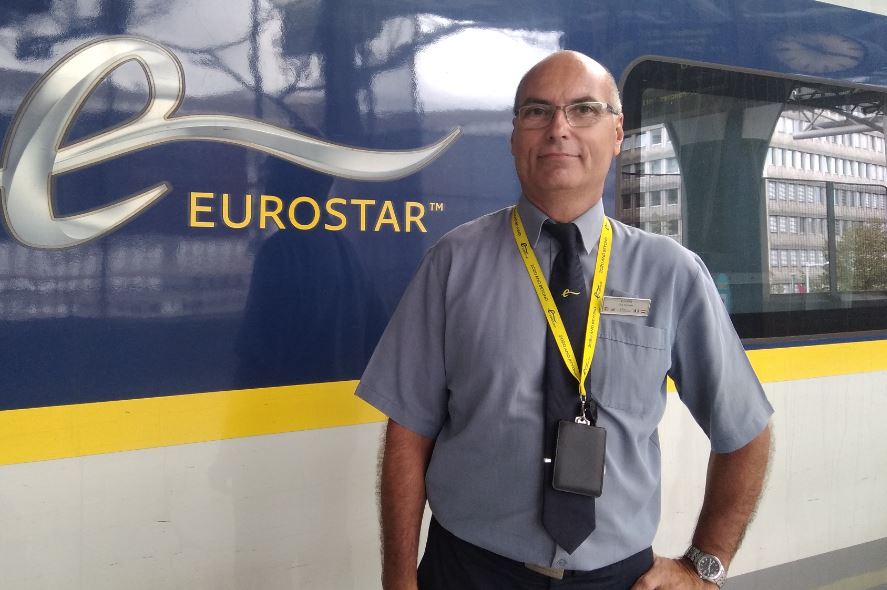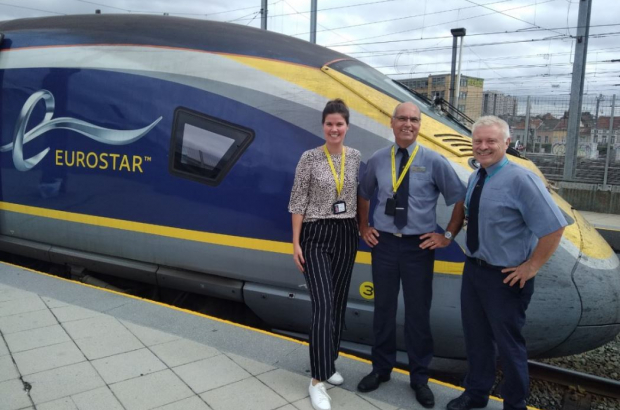- Daily & Weekly newsletters
- Buy & download The Bulletin
- Comment on our articles
Many happy returns: We meet some of the Brussels staff as Eurostar turns 25
Before 14 November 1994, London and Brussels felt much further apart. You could fly, drive on to a Channel ferry or hovercraft, or take the train to Ostend or Zeebrugge, then spend four hours on the crossing to Kent and still face a two-hour rail journey on the other side.
When the Eurostar train service was launched, London Waterloo was suddenly a mere three-and-a-quarter hours from Brussels Midi. Only the French part of the journey used a high-speed line at the time (Belgium followed in 1997, the UK in 2007) and the cheapest return fares were about 5,000 Belgian francs – almost €200 in today’s money, accounting for inflation.
Now the British capital is just two hours away. Jump on a train at 10.56 and you’re in London for lunch. Duty control manager Chris Commere, who is responsible for the Midi terminal’s smooth running, was there when King Albert II and Queen Paola inaugurated the service 25 years ago. “The cleaning machines broke down and we had to clean the whole terminal by hand,” he remembers fondly.
Some 5,000 passengers pass through the departure lounge at Midi every day. “In the last two or three years, every day is busy and all the trains are fully booked,” Commere says. “We can’t put more trains on for the moment, but I’m sure if we had three more trains per day, they would be fully booked.” Not a minute can be lost, and space in the terminal is tight. “The original trains could carry a maximum of 650 passengers,” he adds.
“Now you have nearly 900 passengers per train, with the same capacity in the terminal, the same number of X-ray machines, the same number of staff. It’s challenging every day. You can’t afford to lose five minutes. Our trains have to leave on time, otherwise they lose their slot in the tunnel. You might have to wait another hour for a new slot.”

Missed connections are another potential headache. “If a connecting train is delayed we have to take care of the passengers,” says Commere. “But if all the trains are fully booked you can’t put them on the next train. You have to declassify first-class coaches, upgrade passengers, and if we can’t take them to London on the same day we have to give them a reservation in a hotel.”
In the past 25 years, Commere has seen royalty, ministers and other celebrities pass through Midi. “Most of the time they are very easy,” he says. “But there is one actor, a Belgian guy, very famous. He always turns up 20 minutes before departure, then he leaves the terminal to get a takeaway from Quick. He’ll be given a full meal on board but he still wants to eat his Quick. Every time we tell him, don’t be late, and on every occasion he checks in eight minutes before departure. Most of the time he gets on board, but once he didn’t.”
There is no typical day in this job, but Commere remembers one in particular. “I received a phone call from a hospital. A lady was in the terminal, travelling with her family. I made an announcement for her to come and see me, and when she got to my office I said: I have bad news and good news. The bad news is you can’t travel to London. The good news is the hospital have found a donor kidney for you. She hugged me and started crying. So did I.”
Every five years, Eurostar puts on a big anniversary party for crew; the 25th birthday bash will be in November. “There are about 3,000 colleagues coming from Paris, London, Brussels and Lille,” says Commere. “Every five years you see them again – they just have a bit less hair.”
‘There’s a tunnel?’
Willy Delaet started as a guard on the Belgian railways in 1979 and worked on the glamorous TransEurope Express route to Paris – the precursor to Thalys – before passing the exams to join Eurostar as a train manager in 1995. “The first journey was very stressful but I was with a French crew who were very kind with me,” he says. “I could have retired five years ago but I like my job. I like the contact with the passengers.”
After clocking in for work at Midi about an hour before departure, Delaet passes by the manager’s office to check if there are any passengers requiring special attention, such as VIPs or a large group. Then it’s past the Belgian and British passport controls and up to the platform to prepare the train for boarding.

Each Eurostar has two train managers. “We are there for the passengers’ safety – that’s the first and most important thing we do,” Delaet adds. “It’s a crowded train and we have to resolve problems. It’s not easy if you have a family spread across two coaches. Every coach is full but we try to manage it as best we can.”
Belgium’s future king, Philippe, was one of Delaet’s first VIP passengers. “We were coming back from London,” Delaet recalls. “The prince was in first class and we were very delayed. I asked: ‘Monseigneur, can I do anything for you?’ He asked me to call the palace, to let them know.”
And one day, while he was passing through the train, an elderly couple asked for help. “The man was claustrophobic. I explained to them: I’m sorry, but we have a tunnel - it’s 50km long. They said: ‘Ah, there’s a tunnel?’“
Instant feedback
“I like hearing passengers’ stories,” says Stefanie Van Mierlo, who handles communications for Eurostar in Belgium and the Netherlands. “You can see that the people who work on the trains and at stations go the extra mile for passengers. It’s inspiring for us, because you see how much it can mean to the passenger.”

Van Mierlo joined Eurostar a year ago. “It’s a brand that speaks to the imagination,” she says. “Travelling is something that everybody loves to do and the way that Eurostar is able to connect the continent with the UK is quite amazing.”
Social media has made it easier than ever for passengers to get in contact and screens on board the trains invite them to tweet their comments. “They do that in case of an issue or a problem, but also if they have a positive comment,” Van Mierlo says. “A passenger can say thank you at the time, but if you see afterwards what it actually meant to them, that’s very nice.”
This article first appeared in The Bulletin autumn 2019. Pick up a copy today to read the full article, including interviews with regular Eurostar commuters


















